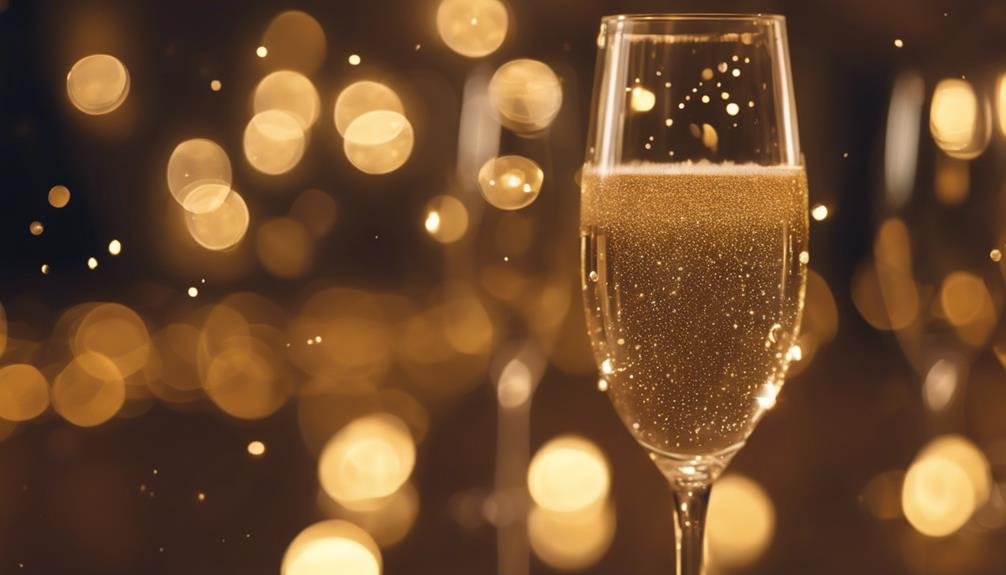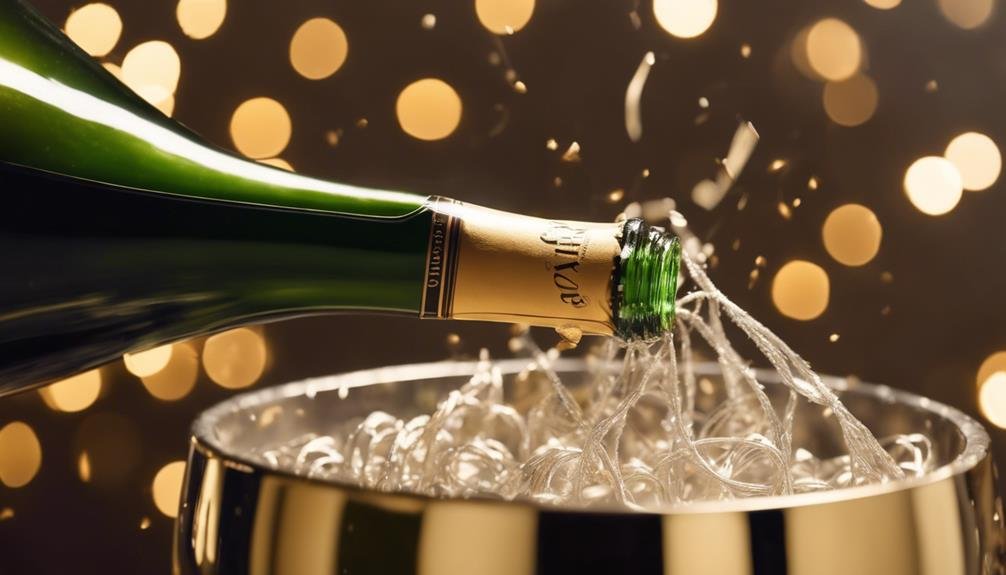Unravel the allure of Champagne by understanding its sweetness spectrum from Brut to Doux, influencing flavor preferences. Explore diverse varieties such as Blanc de Blancs, Blanc de Noirs, and Rosé for unique taste experiences. Engage your senses with Champagne's effervescence, aroma, and luxurious mouthfeel, transforming sips into a decadent sensory journey. Discover perfect pairings like Oysters with Blanc de Blancs and Fried Chicken with Rosé to elevate tasting experiences. Master the art of opening Champagne bottles with finesse and safety measures. Begin an enchanting exploration of Champagne's mystique and intricate delights.
Champagne Sweetness Spectrum
Exploring the Champagne sweetness spectrum reveals the diverse range of residual sugar levels found in each type of Champagne, from bone-dry Brut to lusciously sweet Doux. The sweetness levels in Champagne are indicative of the sugar content and offer distinctive tasting notes.
Brut, the driest Champagne, showcases crisp acidity and citrus notes, while Extra Dry presents a slightly sweeter profile. Moving towards sweeter options like Demi-Sec, you'll notice richer flavors of ripe fruits and caramel. Finally, Doux, the sweetest Champagne, delights with decadent flavors like honey and candied fruits.
Understanding these sweetness levels and their corresponding flavor profiles is essential for selecting the perfect Champagne to suit your palate preferences.
Exploring Champagne Varieties
The diverse range of Champagne varieties showcases the unique flavors and characteristics imparted by different grape varietals and production methods. Grape varieties like Chardonnay, Pinot Noir, and Pinot Meunier play a significant role in shaping the flavor profiles of Champagne.
Blanc de Blancs, made solely from Chardonnay grapes, offers citrusy and apply fruit flavors, while Blanc de Noirs, crafted from Pinot Noir and Pinot Meunier, provides hints of strawberry and white raspberry. Production techniques such as blending blanc Champagne with red wine create Rosé Champagne, known for its fruity notes. Additionally, aging processes like those used in Prestige Cuvée Champagne contribute to top-quality blends.
Understanding these varieties and techniques enhances the appreciation of Champagne's complexity and richness.
Sensory Experience of Champagne

Enhancing the enjoyment of Champagne goes beyond mere taste, delving into a multi-sensory experience that captivates the senses with its effervescence, aroma, and texture.
When you raise a glass of Champagne, you are not just savoring a drink; you are setting off on a journey of discovery. The bubbly bouquets that dance from the glass carry delicate hints of citrus, apple, and brioche, tantalizing your olfactory senses.
Each sip reveals a symphony of flavors, offering tasting notes that range from crisp and invigorating to rich and creamy. The texture of Champagne, with its fine bubbles and elegant mouthfeel, adds a luxurious touch to every sip.
This sensory symphony elevates Champagne from a mere beverage to a decadent experience worth savoring.
Perfect Pairings for Champagne
What are the ideal food pairings that complement the effervescence and flavors of Champagne? When it comes to Champagne, finding the perfect culinary matches can enhance the overall tasting experience. From light snacks to full meals, Champagne can be versatile in its flavorful combinations. Here are some fantastic pairings worth exploring:
| Food Pairing | Champagne Recommendation |
|---|---|
| Oysters | Blanc de Blancs |
| Truffle Popcorn | Vintage Champagne |
| Fried Chicken | Rosé Champagne |
These culinary matches are designed to bring out the best in both the food and the Champagne, creating a harmonious blend of flavors that will leave your taste buds delighted.
Mastering the Art of Champagne Opening

Starting on the journey of mastering the art of opening Champagne involves acquiring a set of refined techniques that enhance the overall experience of indulging in this exquisite beverage. To open Champagne elegantly, start by chilling the bottle to around 45-48°F.
Next, carefully remove the foil and wire cage, ensuring the cork is pointed away from people and objects. Hold the bottle at a 45-degree angle, gently twisting the cork while applying slight pressure until it releases with a soft sigh.
Safety precautions include keeping the bottle pointed away from yourself and others, as the pressure inside can cause the cork to fly out rapidly. Mastering the art of Champagne opening adds an extra touch of sophistication to your celebration.
Frequently Asked Questions
Can Champagne Be Aged Like Red Wine?
Champagne can be aged like red wine, with aging potential varying based on the type. While some Champagnes benefit from aging to enhance complexity, others are best enjoyed young to maintain their fresh fruit flavors and effervescence.
Are There Any Health Benefits to Drinking Champagne?
While champagne can bring joy, moderation is essential. Its antioxidants may offer some health benefits, but excessive consumption can negate them. Mental health benefits like relaxation are possible, but always remember, balance is key.
What Is the Best Temperature to Serve Champagne?
Proper storage of Champagne is essential for maintaining its quality. When serving, the ideal temperature is between 45-48°F to preserve effervescence and flavor. Avoid over-chilling as it can mute aromas and taste nuances.
How Does the Shape of the Glass Affect Champagnes Taste?
The shape of the glass greatly impacts Champagne's taste. Glassware selection influences taste perception by enhancing bubbly characteristics and aroma. Choosing the right glass can enhance the Champagne drinking experience, revealing its full potential.
Can Champagne Be Used in Cooking or Desserts?
Champagne, with its effervescence and flavor profile, can be a delightful addition to cooking and desserts. Incorporate Champagne infused recipes to create sweet champagne treats that elevate dishes, adding a touch of sophistication and complexity to culinary creations.
Conclusion
To sum up, the world of Champagne is as intricate and alluring as a finely woven tapestry. From the delicate sweetness to the diverse array of flavors, there is a Champagne for every palate and occasion.
By mastering the art of pairing and understanding the nuances of this effervescent elixir, one can truly appreciate the decadent delights that Champagne has to offer. So raise a glass, savor the bubbles, and immerse yourself in the mystique of Champagne.
Cheers to a journey of sophistication and effervescence!
